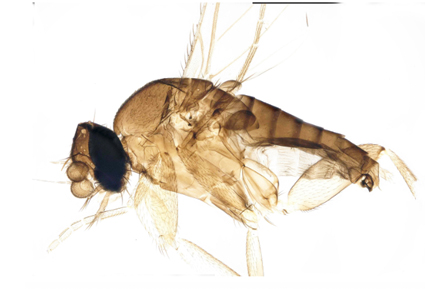Abstract
A collection of 16,521 barcoded phorid flies from Área de Conservación Guanacaste (ACG) in northwestern Costa Rica contains 1,498 recognized BINs (Barcode Index Numbers) in the BOLD database. These BINs were identified to genus, based on photographs, and the collection was found to be composed largely (893/1,498=60%) of specimens of the enormous genus Megaselia Rondani. The nine most common ACG Megaselia, represented by 100 or more specimens each, are briefly described, and diagnosed largely based on DNA barcodes. This study is a prelude and pilot to naming the many less-common species in a similar format.
References
Barnes, J.K. (1991) Additions to the phorid fauna (Diptera: Phoridae) of North America north of Mexico. Florida Entomologist, 74, 305–310. https://doi.org/10.2307/3495311
Borgmeier, T. (1958) Neue Beitraege zur Kenntnis der neotropischen Phoriden (Diptera, Phoridae). Studia Entomologica, 1, 305–406.
Borgmeier, T. (1962) Versuch einer Uebersicht ueber die neotropischen Megaselia- Arten, sowie neue oder wenig bekannte Phoriden verschiedener Gattungen (Diptera, Phoridae). Studia Entomologica, 5, 289–488.
Borgmeier, T. (1968) A catalogue of the Phoridae of the World (Diptera, Phoridae). Studia Entomologica, 11, 1–367. https://doi.org/10.5479/si.00810282.23
Borgmeier, T. (1969) Bredin-Archbold-Smithsonian biological survey of Dominica: The Phoridae of Dominica (Diptera). Smithsonian Contributions to Zoology, 23, 1–69. https://doi.org/10.5479/si.00810282.23
Borgmeier, T. (1971) Further studies on phorid flies, mainly of the Neotropical Region (Diptera, Phoridae). Studia Entomologica, 14, 1–172.
Brown, B.V. (1992) Generic revision of Phoridae of the Nearctic Region and phylogenetic classification of Phoridae, Sciadoceridae and Ironomyiidae (Diptera: Phoridea). Memoirs of the Entomological Society of Canada, 164, 1–144. https://doi.org/10.4039/entm124164fv
Brown, B.V. (2018) A second contender for “world’s smallest fly” (Diptera: Phoridae). Biodiversity Data Journal, 6, e22396. https://doi.org/10.3897/BDJ.6.e22396
Brown, B.V., Hartop, E.A. & Wong, M. (2022) Sixteen in one: white-belted Megaselia (Diptera: Phoridae) challenge species concepts. Insect Systematics & Diversity. [accepted]
Brown, B.V. & Porras, W. (2015) Extravagant female sexual display in a Megaselia Rondani species (Diptera: Phoridae). Biodiversity Data Journal, 3, e4368. https://doi.org/10.3897/BDJ.3.e4368
Brown, B.V. & Wong, M.A. (2021) Identification of Megaselia (Diptera: Phoridae) species using wing vein landmarking. Journal of Natural History, 54, 2513–2527. https://doi.org/10.1080/00222933.2020.1856431
Cumming, J.M. (1994) Sexual selection and the evolution of dance fly mating systems (Diptera: Empididae: Empidinae). The Canadian Entomologist, 126, 907–920. https://doi.org/10.4039/Ent126907-3
Disney, R.H.L. (1989) A key to Australasian and Oriental Woodiphora (Diptera: Phoridae), affinities of the genus and description of new species. Journal of Natural History, 23, 1137–1175. https://doi.org/10.1080/00222938900771031
Disney, R.H.L. (1994) Scuttle flies: the Phoridae. Chapman and Hall, London, 467 pp https://doi.org/10.1007/978-94-011-1288-8
Eiseman, C.S. & Hartop, E.A. (2015) A New Species of Megaselia Rondani (Diptera: Phoridae) Reared from a Macrodiplosis Kieffer (Diptera: Cecidomyiidae) Gall on Black Oak. Proceedings of the Entomological Society of Washington, 117, 463–466. https://doi.org/10.4289/0013-8797.117.4.463
Hartop, E.A. & Brown, B.V. (2014) The tip of the iceberg: a distinctive new spotted-wing Megaselia species (Diptera: Phoridae) from a tropical cloud forest survey and a new, streamlined method for Megaselia descriptions. Biodiversity Data Journal, 2, e4093. https://doi.org/10.3897/BDJ.2.e4093
Hartop, E.A. & Brown, B.V. (2015) Natural blondes: New species of brilliantly yellow-colored and morphologically distinct Megaselia (Diptera: Phoridae) from Central America. Studia dipterologica, 21, 257–265.
Hartop, E.A., Brown, B.V. & Disney, R.H.L. (2015) Opportunity in our ignorance: urban biodiversity study reveals 30 new species and one new Nearctic record for Megaselia (Diptera: Phoridae) in Los Angeles (California, USA). Zootaxa, 3941 (4), 451–484. https://doi.org/10.11646/zootaxa.3941.4.1
Hartop, E.A., Brown, B.V. & Disney, R.H.L. (2016) Flies from L.A., The Sequel: Twelve further new species of Megaselia (Diptera: Phoridae) from the BioSCAN Project in Los Angeles (California, USA). Biodiversity Data Journal, 4, e7756. https://doi.org/10.3897/BDJ.4.e7756
Hartop, E.A., Häggqvist, S., Ulefors, S.O. & Ronquist, F. (2020) Scuttling towards monophyly: phylogeny of the mega-diverse genus Megaselia Rondani (Diptera: Phoridae). In: Systematic Entomology, 56 (1), 1–12. https://doi.org/10.1111/syen.12448
Hartop, E.A., Srivathsan, A., Ronquist, F. & Meier, R. (2021) Large-scale integrative taxonomy (LIT): resolving the data conundrum for dark taxa. BioRxiv. Available from: https://www.biorxiv.org/content/10.1101/2021.04.13.439467v1 (accessed 22 February 2022) https://doi.org/10.1101/2021.04.13.439467
Janzen, D.H., Burns, J.M., Cong, Q., Hallwachs, W., Dapkey, T., Manjunath, R., Hajibabaei, M., Hebert, P.D.N. & Grishin, N.V. (2017) Nuclear genomes distinguish cryptic species suggested by their DNA barcodes and ecology. Proceedings of the National Academy of Sciences, 114, 8313–8318. https://doi.org/10.1073/pnas.1621504114
Janzen, D.H. & Hallwachs, W. (2020) Using DNA barcoded Malaise trap samples to measure impact of a geothermal energy project on the biodiversity of a Costa Rican old-growth rain forest. Genome, 63, 407–436. https://doi.org/10.1139/gen-2020-0002
Meier, R., Shiyang, K., Vaidya, G. & Ng, P.K. (2006) DNA barcoding and taxonomy in Diptera: a tale of high intraspecific variability and low identification success. Systematic Biology, 55, 715–728 https://doi.org/10.1080/10635150600969864
Meier, R., Zhang, G. & Ali, F. (2008) The use of mean instead of smallest interspecific distances exaggerates the size of the “barcode gap” and leads to misidentification. Systematic Biology, 57, 809–813. https://doi.org/10.1080/10635150802406343
Ratnasingham, S. & Hebert, P.D. (2013a) A DNA-based registry for all animal species: the barcode index number (BIN) system. PLoS ONE, 8, e66213. https://doi.org/10.1371/journal.pone.0066213
Ratnasingham, S. & Hebert, P.D.N. (2013b) A DNA-Based Registry for All Animal Species: The Barcode Index Number (BIN) System. PLoS ONE, 8 (8), e66213. https://doi.org/10.1371/journal.pone.0066213
Sivinski, J. (1988) Unusual female-aggregated mating systems in phorid flies. Journal of Insect Behavior, 1, 123–128. https://doi.org/10.1007/BF01052509
Wheeler, Q. (2018) Blank cavas: the case for descriptive taxonomy. Integrative and Comparative Biology, 58, 1118–1121. https://doi.org/10.1093/icb/icy067
Zamani, A., Vahtera, V., Sääksjärvi, I. & Scherz, M. (2020) The omission of critical data in the pursuit of ‘revolutionary’ methods to accelerate the description of species. Systematic Entomology, 46 (1), 1–4. https://doi.org/10.1111/syen.12444

